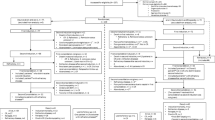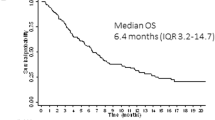Abstract
Acute myeloid leukemia developing secondary to prior cytotoxic chemotherapy (s-AML) encompasses a range of distinct entities. We report two cases of s-AML with inv(16)(p13q22) who had prior exposure to paclitaxel. Additionally, two previously reported cases of s-AML with inv(16) had prior paclitaxel exposure raising the possibility that the taxanes may predispose to this specific syndrome of s-AML. One of our patients received escalated-dose ara-C chemotherapy, achieving a complete remission (12+ months). We therefore examined the prognosis of previously reported cases of s-AML with inv(16) and analyzed the influence of escalated-dose ara-C (⩾400 mg/m2/day). A total of 25 evaluable cases were identified, with 96% attaining CR independent of ara-C dose. The estimated median remission duration was 40 months and the median survival has not been reached (actuarial 5-year survival 52 ± 18%). Although not achieving statistical significance, patients treated with escalated dose ara-C (n = 15) had longer remission duration and overall survival than those treated with standard dose ara-C (n = 10) (P = 0.063 and 0.20, respectively). In univariate analysis, younger age, male gender, and the presence of additional cytogenetic abnormalities were associated with a tendency towards adverse outcomes (P< 0.1). age and gender were equally distributed between ara-c dose cohorts, but more patients treated with standard-dose ara-c had additional cytogenetic abnormalities (P = 0.048). Within the limitations of this retrospective study, this analysis suggests that, similar to de novo AML with inv(16), secondary cases may also potentially benefit from treatment with escalated-dose ara-C. This is consistent with the premise that the underlying molecular defect, rather than the presence of prior cytotoxic drug exposure, may be the most important determinant of disease behavior and chemotherapy responsiveness in AML.
This is a preview of subscription content, access via your institution
Access options
Subscribe to this journal
Receive 12 print issues and online access
$259.00 per year
only $21.58 per issue
Buy this article
- Purchase on Springer Link
- Instant access to full article PDF
Prices may be subject to local taxes which are calculated during checkout
Similar content being viewed by others
Author information
Authors and Affiliations
Rights and permissions
About this article
Cite this article
Seymour, J., Juneja, S., Campbell, L. et al. Secondary acute myeloid leukemia with inv(16): report of two cases following paclitaxel-containing chemotherapy and review of the role of intensified ara-C therapy. Leukemia 13, 1735–1740 (1999). https://doi.org/10.1038/sj.leu.2401552
Received:
Accepted:
Published:
Issue Date:
DOI: https://doi.org/10.1038/sj.leu.2401552
Keywords
This article is cited by
-
The balance between mitotic death and mitotic slippage in acute leukemia: a new therapeutic window?
Journal of Hematology & Oncology (2019)
-
Therapy Related Myelodysplasia/Myeloproliferative Neoplasia-Unclassified with Acute Leukemic Transformation Following Paclitaxel and Carboplatin Based Chemotherapy in an Ovarian Cancer Patient
Indian Journal of Hematology and Blood Transfusion (2014)
-
Therapy-related myelodysplastic syndrome and acute myeloid leukemia following fludarabine combination chemotherapy
Leukemia (2010)
-
Secondary leukemia after first-line high-dose chemotherapy for patients with advanced germ cell cancer
Journal of Cancer Research and Clinical Oncology (2005)
-
Therapy-induced leukemias and myelodysplastic syndromes after breast cancer treatment: An underemphasized clinical problem
Annals of Surgical Oncology (2002)



